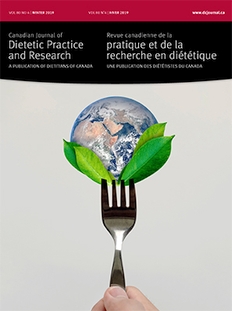Abstract
Purpose: Milk products (fluid milk, cheese, yogurt) typically provide a rich source of calcium and other nutrients, yet consumption is declining in Canada. This study examined milk product health beliefs among young adults and the association between these beliefs and dietary calcium intake.
Methods: Seventy-nine participants (25 ± 4 y; 40 males) completed a milk product health belief questionnaire to determine a milk product health belief score (MPHBS) and a 3-day food record to assess dietary intake.
Results: Despite generally positive views, young adults were uncertain about milk products in relation to health, weight management, and ethical concerns. Females would be more likely than males to increase milk product intake if they were confident that milk products are ethically produced. There was no significant association between MPHBS and dietary calcium intake. Energy-adjusted dietary calcium intake was positively associated with intakes of vitamin A (r = 0.3, P < 0.05), riboflavin (r = 0.5, P < 0.01), vitamin B12 (r = 0.5, P = < 0.01), vitamin D (r = 0.4, P < 0.01), phosphorus (r = 0.4, P < 0.01), zinc (r = 0.3, P < 0.01), and with milk and alternatives servings (r = 0.8, P < 0.01).
Conclusion: Nutrition education efforts focused on increasing calcium-rich food consumption will help consumers to be better informed when making dietary choices.
Résumé
Objectif. Les produits laitiers (lait, fromage, yogourt) constituent généralement une source riche en calcium et autres nutriments, mais la consommation diminue au Canada. Cette étude avait pour but d’examiner les croyances des jeunes adultes quant aux bienfaits santé des produits laitiers, et l’association entre ces croyances et l’apport en calcium alimentaire.
Méthodes. Soixante-dix-neuf participants (25 ± 4 ans; 40 hommes) ont rempli un questionnaire sur les croyances quant aux bienfaits santé des produits laitiers afin de déterminer un score de croyances quant aux bienfaits santé des produits laitiers (SCBSPL) et un journal alimentaire sur 3 jours pour évaluer l’apport alimentaire.
Résultats. Malgré des points de vue généralement positifs sur les produits laitiers, les jeunes adultes étaient incertains quant au lien entre les produits laitiers et la santé, la gestion du poids et les questions éthiques. Les femmes seraient plus susceptibles que les hommes d’augmenter leur consommation de produits laitiers si elles étaient convaincues que les produits laitiers sont produits de façon éthique. Il n’y avait pas d’association significative entre le SCBSPL et l’apport en calcium alimentaire. L’apport en calcium alimentaire ajusté en fonction de l’énergie a été positivement associé aux apports en vitamine A (r = 0,3; P < 0,05), en riboflavine (r = 0,5; P < 0,01), en vitamine B12 (r = 0,5; P = < 0,01), en vitamine D (r = 0,4; P < 0,01), en phosphore (r = 0,4; P < 0,01), en zinc (r = 0,3; P < 0,01), et aux portions de lait et de substituts (r = 0,8; P < 0,01).
Conclusions. Les efforts d’éducation à la nutrition axés sur l’augmentation de la consommation d’aliments riches en calcium aideront les consommateurs à être mieux informés lorsqu’ils font des choix alimentaires.



